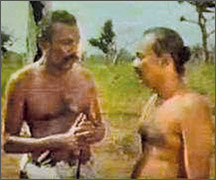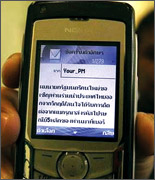|

Dam safety is everybody’s business!
Nalaka Gunawardene and Vindana Ariyawansa
|

Baddegama (Village in the Jungle) - 1980
|
Dam safety discussions receive a boost with ‘Dam 999’, a new feature
film co-produced by UAE and Indian companies and directed by the Indian
entrepreneur turned film maker Sohan Roy. Being released worldwide in
December 2011, this thriller film is described as a “tribute to the lost
souls of the world’s worst man-made dam disasters which claimed a toll
of lives”.
Dam safety concerns everyone in Sri Lanka, which has a high
concentration of man-made water bodies. There are approximately 320
large and medium sized dams in the country, and over 10,000 smaller
dams, creating what are called ‘wewas’ (tanks in English), most of them
built more than 1,000 years ago. The consequences of a major dam failure
in Sri Lanka can be devastating to life, property and the environment.
One such dam disaster happened on April 20, 1986, when the ancient
Kantale dam, 50 feet high and over 13,000 feet long, breached. Its
waters rapidly flooded several villages downstream, killing 127 people
and destroying over 1,600 houses and paddy lands. Livelihood damage ran
into tens of millions of rupees.
In early 2011, when massive and successive floods lashed the
country’s dry zone where most reservoirs are located, more than 200
small dams breached, causing extensive damage to crops and
infrastructure. The most dangerous form of breach, the over-topping of
the earthen dams of large reservoirs, was avoided by timely measures
taken by irrigation engineers.
Today’s Wiz quiz starts with dam related questions to underline the
need for proper maintenance of all dams and reservoirs to ensure maximum
productivity and public safety.
|

A sms
|
1. ‘Dam 999’ film’s culmination is the burst of a controversial dam
in the southern Indian state of Kerala. It was constructed in 1895 by
the British rulers of India to divert water eastwards to the Madras
Presidency (modern-day Tamil Nadu). In 1979, safety concerns were raised
by Kerala state government after a minor earthquake produced some leaks
in the dam. Since then, the dam has been the source of dispute between
the Kerala government and the Tamil Nadu government which is in charge
of the dam and surrounding areas. What is this dam called?
2. The makers of the new movie ‘Dam 999’ also acknowledge the largest
dam-related disaster in history. Between 170,000 and 250,000 people died
(estimates vary) in when a dam burst on the River Ru in Zhumadian
Prefecture, Henan province, in 1975. The dam, built in the 1950s, was
designed to survive a once-in-1000-years flood (300 mm of rainfall on a
single day), but in August 1975, a once-in-2000-years flood occurred,
bursting the dam when more than a year’s worth of rainfall came down on
a single day. The total number of deaths included not only those who
drowned, but those who died subsequently from epidemics and famine
caused. Some 11 million homes were damaged. What was the name of this
dam whose burst the Chinese rulers kept a secret from the world for 15
years (while becoming more focused on dam surveillance, repair and
consolidation of reservoir dams)?
3. The feature film ‘Dam 999’ is partly inspired by an award winning
short documentary made in 2010 by its director Sohan Roy. It questions
the cost benefits of large dams, thousands of which have been built
during the past few decades in India, China and elsewhere. It focuses on
the plight of communities who live directly downstream of reservoirs
enabled by large dams, depicting “the haplessness of the people who
render sleepless nights under the uncertain situation”. What is the name
of this 21-minute documentary film that has won several Indian and
international awards?
|

Beethoven’s Christmas Adventure
|
4. There are different ways to compare dams and reservoirs. One is
the absolute height of a dam from is base or foundation to the top.
Another is the maximum volume of water it can hold, when filled to
capacity, which is not always easy to calculate precisely. While most
large dams in the world today are man-made, some have been caused by
natural events. The Usoi Dam is a natural landslide dam along the
Murghab River in a Central Asian country that was created a century ago
on 18 February 1911, when a major earthquake caused a massive landslide
that blocked the flow of the river. At 567 metres (1,860 ft), it is the
tallest dam in the world, either natural or man-made. In which country
is it found?
5. The International Commission on Large Dams (ICOLD) counts a total
of 37,626 large dams worldwide that are recognised by it as at November
2011. The basic requirement is a structural dam height above foundation
not less than 15 metres. One dam type (based on its construction
material) predominates, accounting for some 63 per cent of all large
dams in the world today. This is also the oldest type and there is
evidence or records or such dams in most ancient civilisations. What is
this dam type which even today is used for some of the tallest dams in
the world?
6 . The 17th Conference of Parties (COP) of the United Nations
Framework Convention on Climate Change (UN-FCCC) just ended in Durban,
South Africa. Who is the Costa Rica born environmental official who
heads the UN-FCCC Secretariat, in which capacity she is the most
prominent climate negotiator in the world today?
7. Who was he? He was a lawyer, journalist and prominent legislator
in colonial Ceylon during the 19th Century. In 1860, he bought the
Examiner newspaper from the British and renamed it as Ceylon Examiner,
thus making it the first locally owned newspaper of which he became
managing editor. He is credited with drafting the currency ordinance
which made Ceylon switch from the British currency to its own of rupees
in 1872, and for coining the term ‘Ceylonese’. He also played a key role
reforming law and education on the island, and in starting Ceylon
Government Railway.
8. Beethoven’s Christmas Adventure is a feature film being released
directly to video (DVD) in November 2011. It is the sixth film featuring
a character named after the composer Ludwig van Beethoven who is part of
the Newton family. The film is the latest in the series that started
with Beethoven in 1992, an American family comedy film directed by Brian
Levant and starring Charles Grodin and Bonnie Hunt. What kind of
creature is Beethoven?
|

Dam 999
|
9. Lester James Peries’s Sinhala movie Baddegama (Village in the
Jungle; 121 min; 1980) was adapted from the 1913 novel written by
Leonard Woolf (1880-1969), an English political theorist and civil
servant who spent the period 1904 – 1911 in colonial Ceylon. The novel,
based on his impressions and experiences of rural poverty in the
Southern Province, where he administered the District of Hambantota, is
considered one of the finest English novels on Ceylon. Name the
Englishman, then domiciled in Sri Lanka, who played the role of Leonard
Woolf in Lester’s movie adaptation Village in the Jungle.
10. A mobile phone application (app) known as ‘iCow’ is helping
farmers in an eastern African country to better manage their herds
through timely expert advice to help maximise their profits. Invented by
Su Kahumbu, an organic farmer, the app allows herders to register their
cows individually and receive tailored text messages to their mobile
phones, containing information on cattle prices, feeding schedules,
veterinary care and more. In which country has this innovation started?
11. A country code top-level domain (ccTLD) is an Internet top-level
domain generally used or reserved for a country, a sovereign state, or a
dependent territory. This is assigned and maintained by the Internet
Assigned Numbers Authority (IANA). For example, Sri Lanka’s ccTLD is .lk
(dot lk). In this scheme, what ccTLD has been assigned to the
Antarctica, which is defined by the Antarctic Treaty (signed in 1959) as
everything south of latitude 60 degrees S. Domain names with this suffix
are available to government organisations who are signatories to the
Antarctic Treaty and to other entities who have a physical presence in
the Antarctica.
12. Timbuktu is a town in West Africa situated 15 km (9 miles) north
of the River Niger on the southern edge of the Sahara Desert. During the
Middle Ages, it was at the centre of many overland travel routes and
became a centre for both trading and learning all over Africa. A number
of notable historic writers described Timbuktu, and their stories
inspired speculation in Europe where the city’s reputation shifted from
being extremely rich to being mysterious. This reputation still lingers,
where many Europeans consider ‘Timbuktu’ as an expression for a distant
or outlandish place. A 2006 survey of 150 young Britons found that a
third of them did not even believe the town existed, while the other two
third considered it “a mythical place”. In which modern day African
state is Timbuktu a provincial town?
13. The world’s first mobile (or cellular) phone call was made on
April 3, 1973 by an American engineer who was standing on Sixth Avenue
in New York City near the New York Hilton hotel. He made the call from a
prototype Dyna-Tac handheld cellular phone (weighing 1.1 kg) before
walking into a press conference upstairs in the hotel. At that time, he
was a vice president and division manager at Motorola phone company and
led the team that developed the world’s first handheld mobile phone. He
has acknowledged that watching Captain Kirk using his communicator
device on the science fiction TV show Star Trek inspired him to develop
the handheld mobile phone. Who is this engineer, considered the
principal inventor of the mobile phone?
14. Short Message Service (SMS) is a text messaging service component
of phone, web, or mobile communication systems, using standardised
communications protocols that allow the exchange of short text messages
between fixed line or mobile phone devices. SMS text messaging is the
most widely used data application in the world, used by three quarters
of the world’s mobile phone users. The Finnish engineer who invented
mobile phone text messaging is a very modest person who was paid Euro
300 for this task. Who is he?
15. Which British middle distance runner won four Olympic medals,
including gold in the 1500m event at Games in 1980 (Moscow) and 1984
(Los Angeles)? He later became a Member of Parliament and was elected to
the House of Lords in 2000. He was also the head of the London bid to
host the 2012 Summer Olympics, and, after the International Olympic
Committee awarded the games to London, became the chairman of the London
Olympics Organising Committee.
Last week’s answers
1. Dr Mrs Kamalika Abeyratne (1934 – 2004)
2. Myung-Bo Hong
3. Shabana Azmi
4. Annie Lennox
5. 45th Annual Tony Awards ceremony in 1991
6. “Gulf of the Ganges”
7. Sir William Ivor Jennings (1903 – 1965)
8. Regi Siriwardena (1922 - 2004)
9. Mahagama Sekera
10. Breaking Dawn - Part 1
11. Liberia
12. Taslima Nasrin
13. Treasure Island
14. D B Dhanapala
15. Shashikala Siriwardena |



